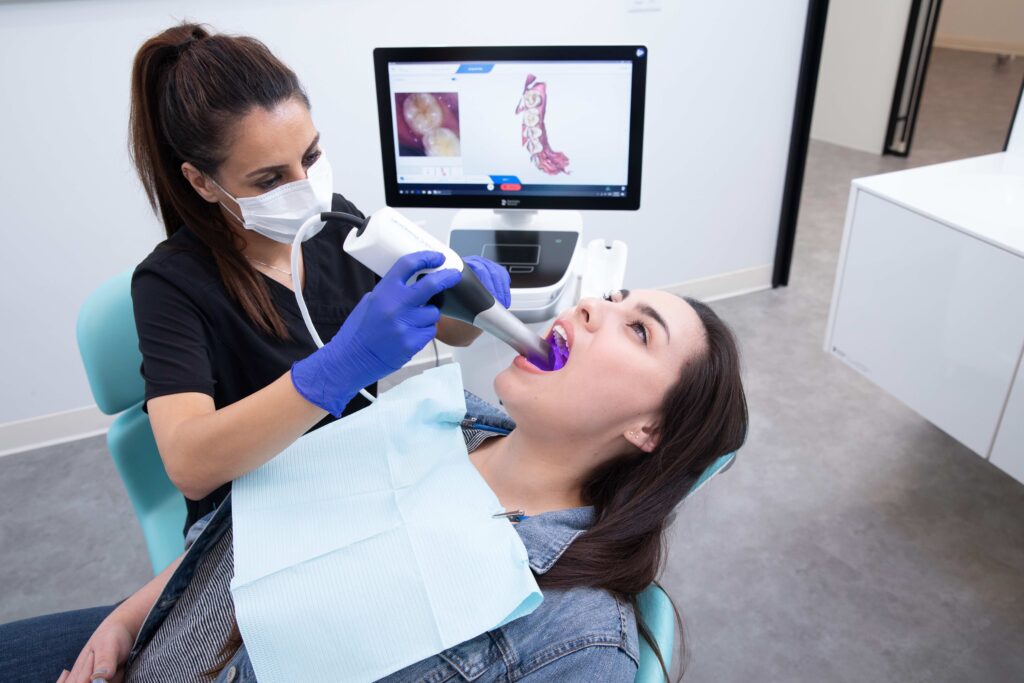In the rapidly evolving field of dentistry, embracing digital workflows has become essential for achieving optimal outcomes in dental implantology. Dental implant labs that leverage digital technologies, such as intraoral scanning and 3D printing, offer numerous advantages for both dental professionals and patients. In this article, we will explore the remarkable benefits of utilizing a dental implant lab that supports digital workflows with intraoral scanning of dental implant scan bodies and the creation of 3D printed models. If you’re considering purchasing an intraoral scanner, or just getting into the game with your first IO scanner, read on to see why digital workflows for dental implant cases make sense.
Enhanced Accuracy and Precision:
- Digital workflows, including intraoral scanning, eliminate the need for traditional impression materials, resulting in improved accuracy and precision. Intraoral scanners capture highly detailed 3D images of the patient’s oral cavity, including dental implant scan bodies. This digital information is then seamlessly transferred to the dental implant lab, allowing for precise planning and fabrication of implant-supported restorations. The elimination of physical impressions reduces the chances of distortion or errors and ensures a better fit and function of the final restoration.
Streamlined Workflow and Time Efficiency:
- Digital workflows in dental implant labs significantly streamline the treatment process, leading to increased efficiency and time savings. Intraoral scanning eliminates the need for physical model creation, shipping, and transportation, thereby accelerating the overall treatment timeline. Dental professionals can digitally communicate with the lab, securely transmitting the scanned data for immediate processing. The lab, in turn, can expedite the fabrication of 3D printed models, reducing turnaround times and allowing for faster treatment planning and implant placement.
Improved Patient Experience:
- The integration of digital workflows in dental implant labs enhances the patient experience in several ways. Intraoral scanning eliminates the discomfort associated with traditional impression techniques, minimizing patient anxiety and promoting a more relaxed dental visit. Furthermore, digital visualization of the treatment plan, including 3D printed models, allows patients to better understand the proposed implant placement and restoration. This increased patient involvement fosters trust, improves treatment acceptance, and enhances overall satisfaction with the implant procedure.
Comprehensive Treatment Planning:
- Digital workflows enable comprehensive treatment planning, aiding dental professionals in achieving predictable and successful outcomes. Intraoral scanning captures accurate digital impressions of dental implant scan bodies, surrounding teeth, and soft tissues. This information can be merged with CBCT scans to create a comprehensive virtual representation of the patient’s oral anatomy. Dental professionals can then precisely plan implant placement, evaluate bone density and quality, assess neighboring tooth positions, and design customized restorations. The ability to digitally simulate and visualize the treatment plan facilitates better communication between the dental team and lab technicians, resulting in more precise and tailored implant restorations.
Precise 3D Printed Models:
- The utilization of 3D printing technology in dental implant labs offers unprecedented advantages. At Element Dental Lab, we’ve invested heavily in 3D printing technology, with a variety of printers and materials printed. With digital data from intraoral scans, dental labs can create accurate and highly detailed 3D printed models. At Element Dental Lab, our high-end 3D printers print with a level of accuracy that allows us to completely eliminate analog impressions and stone models. We can also 3D print a digital mockup to be used in place a traditional waxup that allows direct communication with the patient in visual and tactile way. These improved case presentation techniques aided by dental 3D printing technology can not only improve case acceptance, but will help to keep you and your patient on the same page from start to finish.
Cost Savings:
- In addition to the numerous clinical advantages, utilizing intraoral scanners and scan bodies in dental implant labs can also result in significant cost savings. Traditional impression techniques often require the use of impression transfer copings and polyvinyl siloxane (PVS) impression material, which can be expensive. By replacing these materials with intraoral scanners, the need for impression transfer copings and PVS material is eliminated. This not only reduces material costs but also minimizes the risk of impression distortions or remakes, which can further save valuable time and resources. The initial investment in intraoral scanning technology and scan bodies can be quickly offset by the long-term cost savings achieved through decreased material consumption and improved workflow efficiency.
Q: What is intraoral scanning, and how does it benefit dental implant labs?
A: Intraoral scanning is a digital technology that allows for the capture of highly detailed 3D images of a patient’s oral cavity, including dental implant scan bodies. These scans offer improved accuracy, eliminate the need for physical impressions, streamline communication with dental labs, and enhance treatment planning for dental implant restorations.
Q: What are the advantages of using 3D printed models in dental implant labs?
A: 3D printed models provide dental professionals with tangible and accurate representations of a patient’s dental anatomy. These models allow for precise treatment planning, assessment of bone quality, simulation of implant placement, and fabrication of surgical guides. The use of 3D printed models improves procedural accuracy, reduces surgical risks, and contributes to the overall success of dental implant treatments.
Q: How does utilizing digital workflows save time in dental implant procedures?
A: Digital workflows, such as intraoral scanning, eliminate the need for physical impression materials, model creation, and shipping. This streamlines the treatment process by reducing turnaround times and allowing for immediate transfer of digital data between dental professionals and labs. The elimination of physical models and improved communication expedites treatment planning and implant placement, saving valuable time for both dental professionals and patients.
Q: What are the cost savings associated with using intraoral scanners and scan bodies in dental implant restorative?
A: Utilizing intraoral scanners and sterilizable scan bodies can result in significant cost savings. Traditional impression techniques require the use of analog impression transfer copings and expensive polyvinyl siloxane (PVS) impression materials. By replacing these materials with intraoral scanners, the need for impression transfer copings and PVS material is eliminated. This reduction in material costs, along with minimized risk of impression distortions or remakes, can lead to substantial long-term cost savings for dental implant labs.
Q: Can digital workflows with intraoral scanning and 3D printed models improve patient satisfaction?
A: Yes, digital workflows positively impact patient satisfaction. Intraoral scanning eliminates the discomfort associated with traditional impression techniques, reducing patient anxiety during dental visits. Additionally, the ability to digitally visualize the treatment plan using 3D printed models allows patients to better understand and actively participate in the decision-making process. Improved patient involvement fosters trust, enhances treatment acceptance, and ultimately improves overall patient satisfaction with dental implant procedures.
Q: Are digital workflows with intraoral scanning and 3D printed models suitable for all types of dental implant cases?
A: Yes, digital workflows are highly versatile and adaptable to various dental implant cases. Whether it’s a single tooth replacement, multiple missing teeth, or full-arch restorations, intraoral scanning and 3D printed models can be utilized to plan and execute precise implant treatments. The flexibility of digital workflows allows dental professionals to tailor the treatment approach according to the specific needs of each patient.

